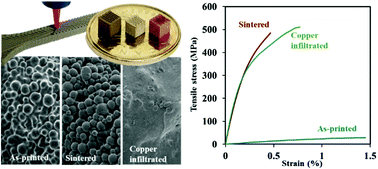Solvent-cast based metal 3D printing and secondary metallic infiltration†
Abstract
Affordable 3D printing methods are needed for the development of high performance metallic structures and devices. We develop a method to fabricate dense metallic structures by combining a room temperature 3D printing and subsequent heat-treatments: sintering and secondary metallic infiltration. The high flexibility of this method enables the fabrication of customized 3D structures, such as fully-filled, porous, interlocked and overhung structures. These geometries are printed using a highly concentrated metallic ink (metallic load up to 98 wt%) consisting of highly alloyed steel (HAS) microparticles, polylactic acid (PLA) and dichloromethane (DCM). In order to improve the mechanical properties and the electrical conductivity, the as-printed structures are sintered and infiltrated by copper in a furnace protected by a mixture of H2 and Ar. The filament porosity of the copper infiltrated samples is as low as 0.2%. Mechanical testing and electrical conductivity measurement on the copper infiltrated structures reveal that the Young's modulus reaches up to ∼195 GPa and the electrical conductivity is as high as 1.42 × 106 S m−1. Our method enables the simple fabrication of high performance metallic structures which could open up new technological applications where cost is an important factor.

- This article is part of the themed collection: 2017 Journal of Materials Chemistry C HOT Papers


 Please wait while we load your content...
Please wait while we load your content...